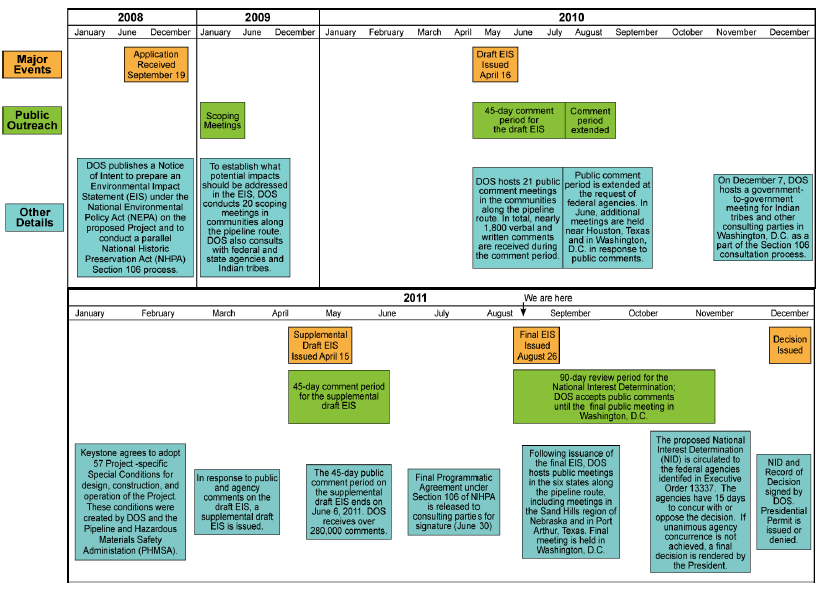Our Fossil Fuel Future – Part I: The Keystone XL Pipeline
[Breaking News Addition: Nebraska farmers and ranchers pack Keystone hearing– demand project be stopped!]
While teaching a lesson today on the creation and passage of the 1970 National Environmental Policy Act (NEPA) by President Nixon, one of my students asked if the Keystone XL pipeline had gone through the process of environmental review we were discussing, in particular an Environmental Assessment (EA) or an Environmental Impact Statement (EIS), and what the outcome had been. I had to admit I wasn’t sure, which wasn’t an ideal answer, but it is what it is. So after doing a bit of updated research on the project, I decided I would just turn this into another teachable moment, both for myself and for others.
But I must also admit to having an ulterior motive, namely the incessant rage I feel when reading an article like this one from the end of the summer about this project. The NY Times story, U.S. Offers Key Support to Canadian Keystone XL Pipeline, was enough to set me off, but then against my better judgement I began reading through the 200+ comments on the story. And I should mention I am working on my dissertation proposal as well right now, which is largely about environmental politics and the current state of global denial. So in large part this was the perfect example of one of those “really, are you serious, ugh!” moments.
Background on the Keystone XL Project
- Who is proposing the pipeline?
TransCanada, LP, a Canadian-based oil and gas company operating across all of North America. Their current corporate assets are valued at $46.6 billion (2010 figures). Their stocks currently trade as TRP (TSX, NYSE), and their shares were trading at $40.49 on the NYSE as of the end of September.
- What will the pipeline do?
Transport crude oil from the Western Canadian Sedimentary Basin (via a supply hub in Alberta, Canada) to U.S. refineries in Oklahoma and Texas. It will also serve as a connection point for at least one major domestic oil reserve or production site located in the upper Midwest (Bakken). According to official documents, the project is estimated to be able to transport up to 830,000 barrels per day (34,860 gallons/131,959 liters), with an estimated cost of $7 billion.
- Where will the pipeline run?
According to the TransCanada website:
“The proposed Keystone Gulf Coast Expansion Project is an approximate 2,673-kilometre (1,661-mile), 36-inch crude oil pipeline that would begin at Hardisty, Alberta and extend southeast through Saskatchewan, Montana, South Dakota and Nebraska. It would incorporate a portion of the Keystone Pipeline (Phase II) through Nebraska and Kansas to serve markets at Cushing, Oklahoma before continuing through Oklahoma to a delivery point near existing terminals in Nederland, Texas to serve the Port Arthur, Texas marketplace.“
Here’s a nifty little map they put together showing the various phases of the project.
[swfobj src=”http://www.transcanada.com/media/keystone_map.swf” width=”500″ height=”512″ align=”center” allowfullscreen=”false”]
- What will the impacts of the project be?
According to TransCanada and the Obama administration, the impacts will only be good.
“Secretary of State Hillary Clinton is due to rule on the project by year’s end. Her department released an environmental assessment that concluded after three years of study that Keystone XL would have minimal impact.“
But not everyone in Washington agreed, key among them was the EPA, as TruthOut reports in their coverage:
“Initially, the EPA gave the State Department its lowest grade of “inadequate” back in July 2010 when Clinton’s team issued its first draft of the environmental review. That dressing-down forced the department to collect more data before completing a revamped draft last April. In June, the EPA bumped up its grade on the second attempt from “inadequate” to “insufficient information.”
Shortcomings cited by the EPA included failing to fully address safety and oil spill risks, not considering an alternate route, as well as missing the mark on calculating lifecycle greenhouse gas emissions, the potential damage to wetlands and migratory birds, and the dangers to Native Americans and other at-risk communities.“
According to the environmental community the project is the height of arrogance, a betrayal by the Obama administration, a clear sign that absolutely nothing was learned by the Gulf Oil spill, and more proof that the energy and gas industry is increasingly determining the shape of the U.S. energy policy, rather than Congress or the public. They also point out that even the normal environmental policies, such as NEPA, are not being followed here, which raises even more questions about the legitimacy of the project.
“Conservationists are wary of the national interest determination portion of Keystone XL because it isn’t covered by the clear standards laid out in the National Environmental Policy Act (NEPA). The White House Council on Environmental Quality (CEQ) is responsible for coordinating NEPA.
NEPA’s strength, watchdogs say, is that it required the State Department to listen and respond to public comment during the pipeline’s environmental evaluation process. They fear the upcoming hearings in the six affected states won’t receive equal treatment.
“The national interest determination is a highly discretionary process,” Ryan Salmon, energy policy adviser with the National Wildlife Federation, said in an interview. “Unlike NEPA, there are no formal criteria for soliciting and considering public views.”
Rules for the national interest determination concerning energy are laid out in a three-page executive order signed by President George W. Bush in 2004.“
In my own research I was not able to determine why the original proposal was made to the Secretary of State, thus invoking the National Interest Determination (NID) review process, except that it involves energy infrastructure and is a cross-border project. From everything I can tell, this process is far weaker and less stringent in its review and impact evaluation process than a standard NEPA policy review through a federal agency, as opposed to the DOS. However, I admit to not knowing much about the NID, as this is the first time I have heard of a project using this process, and have never directly been involved in any NID-reviewed projects, unlike NEPA, which I am quite familiar with as a project review process.
Over on Wall St., the analysts TD Waterhouse reported mixed sentiments this week, primarily emphasizing the likely delays from lawsuits as the project moves towards its final stage of construction: Snags lurk for Keystone XL even after US approval.
“Even if it gets the State Department’s green light, legal and regulatory snags lurk at federal and state levels and each could mean more costly delays to the $7 billion project, which is intended to move more than half a million barrels of oil sands-derived crude oil a day to Texas from Canada.
Environmental groups are girding for a host of battles aimed at putting the brakes on Keystone XL, which is already about a year behind schedule, legal sources said. The first lawsuit over wildlife could be filed this week.“
- What is the current status of the project?
The initial project was proposed to President Obama in 2008 via a Presidential Permit with the Department of State. After the required public comment and review periods, a Final Environmental Impact Statement (FEIS) was released by the Department of State on August 26, 2011, starting a 90-day National Interest Determination (NID) review and comment process.
So we are currently one month into the comment period, which will end in late November. This process, which is known as a National Interest Determination (NID), includes the public, interested parties, as well as all the federal agencies listed in Executive Order 13337, with the intent to evaluate the “national interest” of this project to the United States. If all of those agencies listed in EO 13337 agree with the final determination of the DOS–which is possible–then the permit is cleared for approval and publication in a Final Record of Decision (ROD). If there is not consensus by the federal agencies, then Secretary Clinton (or the President himself) will make a Final Determination on the project. So in all reality, approval for this massive project will likely come down to a choice made by President Obama sometime in December, 2011.
Until then, people on all sides of the issue are organizing their resources, directing people to the public comment pages of the DOS (click here to comment), and lobbying both in Washington and in the Midwest states where the pipeline will pass through. What the final result will be remains to be seen, but one thing is clear, no good can come from a massive 1,700 mile pipeline carrying tar sands crude oil that runs directly over the largest freshwater reserve in the U.S.–the Ogallala Aquifer. If people think hydrofracking is bad, imagine a spill the size of the Macondo Well in the Gulf pouring directly into these aquifers. It would seem like the risk of poisoning the drinking water for some 2 million people, not to mention most of the Midwest’s agricultural irrigation waters, might constitute a “significant” environmental impact.
At least, you would think so…




